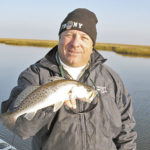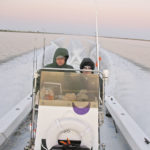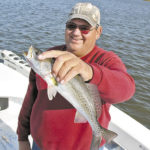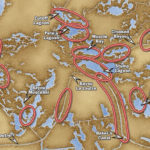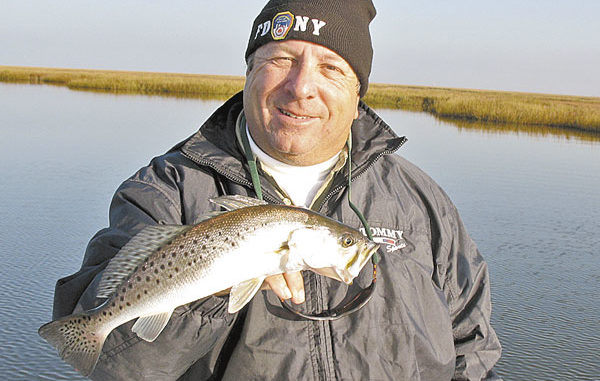
Cold weather got you down? Head to this chunk of marsh, and you’ll proclaim January as your favorite month of the year.
There’s a lot of ways to bring in the New Year. Pop a few fireworks, celebrate with friends, toast 2010 at midnight on New Year’s Eve or you could do what hardy anglers do all over the Southeast Louisiana marsh — go fishing. Granted, our winter fishing isn’t as bitter as the poor souls who have to cut holes in the ice of a frozen lake and fish all day hoping to catch a minnow. But it gets cold down here in our marsh come winter, mighty cold, as you already know.
I’m sure a meteorologist could explain in complex technical terms why it feels just as cold down here as it does up north. In layman’s terms, we just say, “It’s the humidity,” and let it go at that. And it actually is the humidity that makes our cold so, well, cold. It’s a damp, wet, penetrating-down-to-your-core kind of cold. It’s the kind of cold that erases all the tough-guy bravado. Five minutes into a cold morning boat ride turns the coatless macho man into a quivering girl.
I learned a long time ago, it’s going to be colder than you think. Better to bring more clothes than you need than to freeze your goola because you were too macho to bring a jacket.
On precisely one of those damp, cold mornings, I unloaded my gear into Capt. Johnny Nunez’s boat at his dock in Shell Beach (504-239-3159). Nunez was actually born and raised in Shell Beach, and like his father before him, he grew up fishing, crabbing, hunting and trapping throughout the surrounding marshes.
I’d asked him to take me deep into the Biloxi Marsh to see if we could find some trout despite the cold weather. We climbed aboard his 25-foot Privateer powered by a 350 Yamaha. Capt. Dane Bennet hopped on to round out our crew, and we putted down the bayou to Campo’s Marina, where we picked up some live bait. Minutes later, we crossed the MRGO and headed toward Lake Borgne.
“There are hundreds of places to fish down here,” Nunez said, “even in winter. The fish don’t leave. They go deep, and their metabolism slows down a bit, but they’re still all over the marsh, they’re still hungry and you can still catch a bunch if you know what to look for.”
If I were a fish, I know what I’d be looking for on such a cold morning — a fire to warm up by. The fish want to warm up too, but without a fire, they look for the next best thing —sunshine.
“As soon as the sun gets up and you feel the warmth of the sunshine, the trout are coming up out of the deep holes, and they’re going to fan out over the flats and shallow reefs,” Nunez said. “That’s where the bait will be, and that’s where the fish will be. Even on these cold mornings, we’ll fish under corks in water 2 to 4 feet deep.
“On those really cold days when the sun can’t break through the clouds, or in the early mornings, you’ll have to fish deeper water. That’s when you stay in the bayous and canals, and fish your bait slow off the bottom.
“I like to fish the back side of Bayou LaLoutre, the deep turns in Crooked Bayou and the first part of Bayou Sue. Anywhere that has moving water and deep holes, such as you’ll find in the turns, at the cuts and in the mouths of the bayous, and there’s dozens of places like that all over this marsh.
“But the fact is, we don’t get a whole lot of really cold weather. And even when we do get a hard cold front blow through, it doesn’t last long. We always get a warm up after a couple days.
That means several things to a fisherman. One, pick the better days to fish, if that’s possible. And two, you don’t have to worry about getting on the water at the break of daylight — that’s not important in the winter. Often it’s better to leave a bit later and let the sun warm everything up a little while.”
I learned long ago that the sun reverses its role in the winter months. It turns from enemy to friend. In the dog days of summer, you have to get on the water at the crack of dawn (better yet, before daylight) in order to jump on the morning trout bite because once the sun gets up, the fish shut down. So, in summer, the sun is the enemy.
But in winter, the sun switches roles and becomes the angler’s friend. You don’t want to be on the water on those bitter-cold days until your friend, the sun, shows up to warm things up for us and the fish. Forget the 3 a.m. wake-up call. Sleep late. Poke around, get another cup of coffee, let things warm up a bit, then go fishing.
We took a cold boat ride across Lake Borgne to the mouth of Bayou Sue where Nunez stuck the Cajun anchor, and we soaked some live bait under corks. He said the trout had been plentiful there recently, and he hoped to put us on a good early morning bite. Ten minutes later, after nary a bite, we headed inside Bayou Sue.
“This whole front section of Bayou Sue can be very productive in the winter,” Nunez said as we zipped down the waterway. “You can drift or troll and drag some plastic baits behind you, letting them bounce along the bottom. Or you can anchor at the holes in the turns and cast live baits on a Carolina rig.”
We entered a maze of broken marshland that was riddled with ponds, and Nunez took a meandering path through them that I wouldn’t attempt to duplicate (which was probably why he took that route). The water was actually high despite the winter cold, and now that the sun was making its presence known, he was certain the trout would be chasing bait in the shallow water. Once Nunez was convinced I was thoroughly lost, he stopped and drifted across one of the large no-name ponds.
Nunez and I both loaded up with live bait about 18-24 inches under a cork, while Captain Bennet tossed plastic. He had a glow/chartreuse Hybrid on a plain jighead that he was convinced the trout wanted. They didn’t. They wanted the live stuff, and Nunez and I fed it to them.
Nunez stuck the Cajun anchor, and for a solid hour, we pounded the trout. Bennet eventually switched over to live bait and joined the action, while I tried a glow DOA shrimp under a cork. The trout hit the DOA aggressively, and it seemed that I initially caught slightly larger fish on the plastic.
Bennet switched back to plastic again, this time to a Billy Bay halo shrimp in the lime/clear color, and the trout hit it also. But Nunez never wavered from his commitment to the live bait, and he did out-catch us by a significant margin.
“I fish with live bait because I like the odds to be in my favor,” Nunez said with a grin, as he dropped another trout in the box.
We did have some throwbacks in the mix, but most of the fish were in the 13- to 14-inch range.
“What you want to do is to look for areas like this, either deeper ponds or shallow lagoons, where there is some current moving,” Nunez suggested. “If the water is dead, the fish won’t be there. Current moves the bait and triggers a feeding instinct in the fish. And you want decent water. If it’s all muddy or cloudy, look elsewhere.”
Nunez says the normal winter hotspots should all produce some good fish this year.
“Stump Lagoon is always a good place to drift or troll,” he said. “Drift anywhere in the lake, and fish live bait, either shrimp or minnows, under a cork. If you get into some action, stick the anchor and stay with it. When it stops, pull the pole and resume your drift.
“Mack’s Pass is another good place to troll or drift and anchor when you find the fish. The problem there is the continual boat traffic, and not everybody slows down when they pass you. It seems like every time you get on a good bite, a boat passes and shuts the action down again. It’s frustrating.”
Nunez also likes to drift the south side of Muscle Bay and the passes on each end of it.
“There are some good points in Muscle Bay that can be very productive, especially along the south side of the bay,” he said. “And the bay just to the east of Muscle can be productive as well.
“Like I said, there are hundreds of places to fish out here. Try drifting Pete’s Lagoon, and Cut Off Lagoon, Drum Lake and the ponds off Bayou St. Malo. The options are endless. And if you want redfish, just drift or troll closer to the bank, in all those same areas, and use live bait or market shrimp under a cork. Or you can toss spoons and spinners and plastics.
“I like to anchor at a good point where the current is moving and cast a live minnow under a cork right up against the bank. Cast along the bank, especially at points, drains and cuts and coves, and if reds are anywhere near, they’ll find it. It won’t take them long. If you don’t catch anything in five or 10 minutes, move.”
Over the course of the morning, we made a few moves, and each time we found some fish, mostly in the shallow water. Nunez says the fish will gradually gravitate to deeper water as the water temperatures drop and winter deepens, but they’ll not forsake the shallows altogether.
“Naturally, when the tides are low and the weather is cold, you’ll want to fish the canals and bayous,” he said. “Anchor or slow drift, and bounce your bait off the bottom, slow. The bite will be slight, so you’ll want a sensitive rod tip, nothing too soft or spongy. Braided line also adds some sensitivity.
“But when the sun comes out, and especially when the temperatures moderate and the tides are up, fish shallow, under a popping cork. That’s where they’ll be.”
Capt. Johnny Nunez can be reached at (504) 239-3159.
